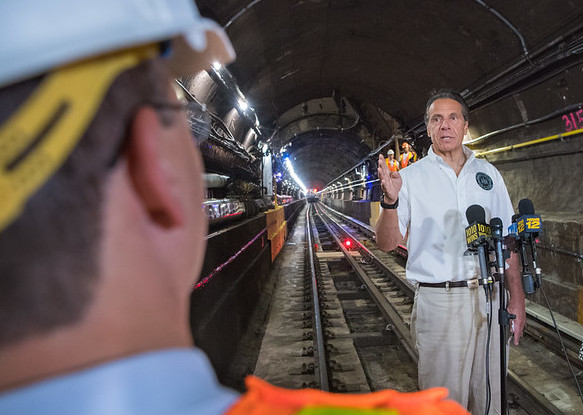
Gov. Cuomo should close the subways, the author writes (photo: Governor's Office)
New York City is the epicenter of the coronavirus crisis in the United States. State and city authorities are pleading with residents to stay home, shelter in place, and maintain distance from fellow New Yorkers to slow the wave of cases crashing into the city’s healthcare facilities.
Yet, public transportation was running on the standard weekday schedule as of Monday morning. With subway ridership down ridership down 87%, the response on Tuesday was to cut trains by a quarter.
Such quarter-measures will not serve the city well. A full closure of the subway is needed, along with steps to dedicate buses and other transportation services to the essential workers who are saving lives and keeping the city running. As drastic and disruptive as shutting down the subway sounds, doing so can slow the spread of the virus. Apart from the exigency of the public health crisis, the unprecedented fall in ridership also offers an opportunity to undertake repairs and fixes that would be disruptive in normal times -- and help set the stage for the system’s recovery.
There is an irreconcilable tension between running public transport essentially as normal while authorities order folks to stay at home. Public transportation accounts for most trips within the city, and the virus travels alongside passengers in the confined spaces of trains and buses. Public transit was suspended on the first day of the lockdown in Wuhan, China in order to slow the circulation of people and the virus they may carry, and Chinese public health officials have urged cities to suspend service in other affected countries. MTA workers -- not to mention CEO Patrick Foye -- are falling ill themselves and the decision to run fewer trains has increased crowding, and thus transmission risks.
The MTA needs to immediately cease providing fully “public” public transportation. Addressing this crisis requires taking seriously the real economic, social, and health costs of continuing to provide service, and beginning to think about how the system can recover after the crisis.
The MTA should shut down all subway lines and use the time for several weeks’ worth of dedicated repairs, accomplishing fixes that would in normal times have to be stretched over months or years. Typically, major disruptions to train operations for necessary repairs are impossible or at least extremely difficult due to rider pushback, even when closures allow for faster and cheaper progress.
The subway is the circulatory system of New York City. In drastic open-heart surgeries, the heart is stopped and damage repaired to help the patient come back healthier. Taking advantage of a time when circulation needs to halt to ensure the health of the subway when it restarts is prudent and will allow New York to come back from this crisis stronger than before.
This would be an effective use of money set aside for public transportation in the new federal stimulus bill, and closure will also help strengthen existing shelter-in-place orders to slow the spread of the virus throughout the city. With ridership already at historically low levels, coupled with an imperative to minimize travel, the typical disruptions from repairs are minimized. Making progress on the extensive backlog of much-needed repairs to dilapidated stations, outdated power systems, and other priorities while advancing progress on essential signals upgrades will help the subway emerge more reliable and faster for New Yorkers after the crisis, which will help the system more quickly recover ridership.
There are, of course, major logistical challenges that must be overcome to make such a plan workable. For one, healthcare providers and other critical workers need to get to their jobs. MTA buses should be dedicated to the transport of essential workers only, maintaining existing routes on streets cleared of competing traffic. For essential workers unable to commute by bus, the city should draw on its taxi fleet to provide alternative transportation or partner with app-based services.
Care will also need to be taken to ensure the health of workers undertaking repairs. Workers will need to be screened (at least for their temperatures, if coronavirus testing delays persist), worksites will need to be consistently monitored for transmission risks, and workers must be provided guaranteed care in the case that transmission does occur on the job. Practices and procedures will have to be adapted to match the needs of these unusual times.
Slowing the spread of the coronavirus in New York requires dramatic actions, and halting public transportation to reinforce existing orders is just one needed step. Stopping the trains now and using the time to make necessary repairs can also lay the foundations for New York’s recovery by creating the opportunity for the city, and its public transportation, to bounce back better than before.
***
Patrick Farrell is a Master in Public Affairs student concentrating in economics and public policy at Princeton University with prior experience as a researcher focused on urban economics at New York University. He is a co-author of the article Social Connectedness in Urban Areas, which explores the distribution of social networks in New York City and the role of public transit in shaping them.
***
Have an op-ed idea or submission for Gotham Gazette? Email This email address is being protected from spambots. You need JavaScript enabled to view it.




